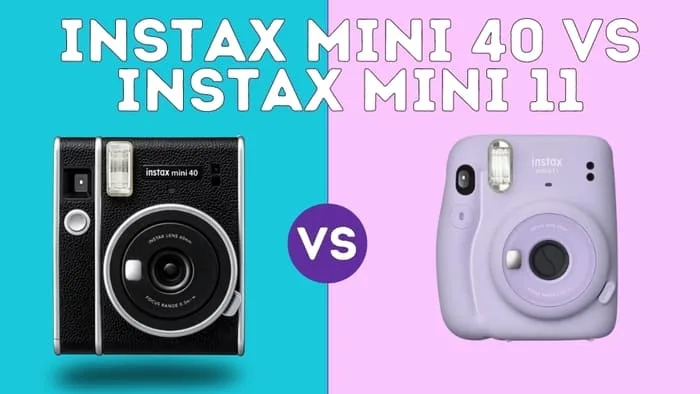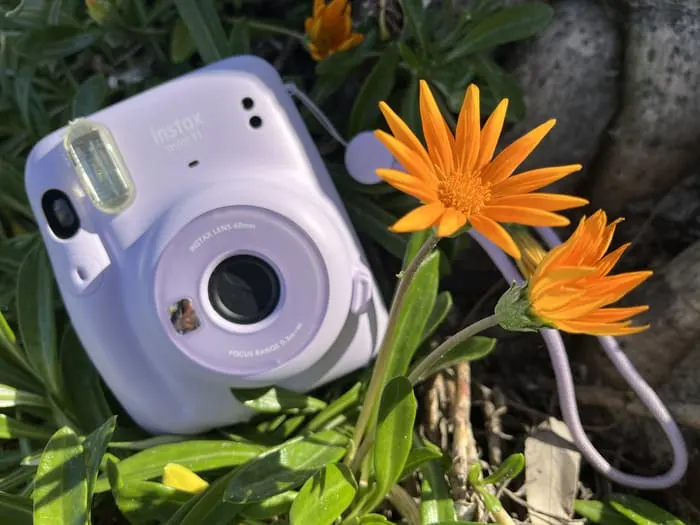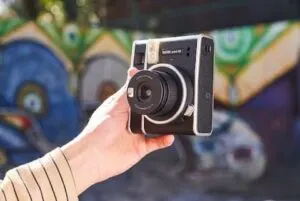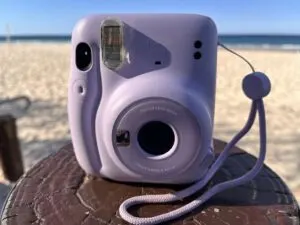In the realm of instant photography, Fujifilm’s Instax Mini line has garnered immense popularity. Now, the brand-new Instax Mini 40 has joined the family, boasting a vintage-inspired design that sets it apart from its predecessor, the Instax Mini 11.
But don’t be fooled by their distinctive appearances – when it comes to specifications, these two cameras are remarkably similar.
My bottom line: When it comes to the Instax Mini 40 vs Mini 11, the key differentiator lies in their designs and pricing rather than their specifications. While the Mini 40 offers a vintage charm and a slightly higher price tag, the Mini 11 provides the same performance at a more affordable cost.
Instax Mini 11 vs 40

Despite polarizing designs, the Fujifilm Instax Mini 40 and Mini 11 are very similar in specifications. Therefore, I compared these two models, even though the Instax SQ1 was released between them.
You will see little difference in performance between the two instant cameras. The most significant difference (along with the price) is the look and feel of the two models.
The Instax Mini 40, in many ways, is the Mini 11 repackaged in a more vintage design. So, if you seek a more professional-looking camera on a lower price scale, the Mini 40 is the right option.
The two instant cameras have a few differences regarding camera weight and dimensions. Let’s detail the main features of the Instax Mini 40 and 11 to find out which one should be your pick.
Instax Mini 40 and Mini 11 Features Comparison
As I look at the technical specifications, you will find little (if any) difference between the two models. The key features of the two models, excluding the design, are the same.

Design
The build and design of the two models are distinctive.
The five pastel colors and rounded body of the Mini 11 are replaced by a sharper-edged, textured body, miming the retro rubberized Fujifilm cameras. The optional case sold with the Mini 4o instant camera is again on theme with an all-black classical look.
On the other hand, the Mini 11 is a more-rounded model, with a bulbous front than the Fujifilm Instax Mini 40’s flatter surface.
The film loading door for both models is at the back, along with a front panel mirror to aim for selfies. The Instax Mini 40 also does not have a tripod thread – which is found on the pricier models like the Mini 70 and 90. The same goes for the Mini 11.
READ NEXT: Instax Mini 70 vs Mini 11: Which Camera Suits Your Style?
The Mini 11 is slightly bigger but lighter than the Mini 40.
Lens and Instax Mini Film
The Instax Mini 40 and 11 use the Instax Mini instant film and have the same lens (2 components, 2 elements, f = 60 mm, 1:12.7). Thus, they share the same auto exposure control, shooting range, and shutter speed. The film, in both cameras, develops in approximately a minute and a half.
Since the specifications are the same, the result is also the same.
The Instax Mini 40 and the Mini 11 produce the same image quality and camera performance, which can be slightly disappointing for some in an upgrade that usually accompanies a newer model.
The Mini 40 having the same images is not necessarily a con.
The Mini 11 is an excellent instant camera thanks to its automatic flash adjustment, and it makes for great photos on alternative light settings. The effective flash range is between 0.3 to 2.7 meters.
On the other hand, the shooting range is 0.3 meters and beyond. While in selfie mode, you can shoot between 0.3 to 0.5 meters.
Viewfinder
The Mini 40 and 11 have a 0.37x optical viewfinder with a target spot.
The viewfinder can have accuracy issues, especially when the object is closer. By accuracy issues, we mean that what you can see through the viewfinder may not appear precisely in the frame once the image develops.
Unlike a DSLR, the viewfinder does not look through the lens in both the cameras (and other mini models). This results in discrepancies in the image as the viewfinder and the lens see two different scenes. This can cause framing issues.
If the object is 1 meter away from the camera, the lens lines up nicely, but you may need to adjust the frame before you click the button for anything closer.
For objects over 1 meter away, the picture covers more area than seen on the viewfinder, especially on the sides. However, at fewer than 0.5 meters, the subject and print have a significant difference.
So, a better technique for objects at about 0.3 meters would be to line up the lens manually rather than look through the viewfinder.
While these discrepancies have a certain charm to the instant photos taken from these cameras, it is essential to note that despite being the newer model, Instax Mini 40 does not rectify these issues by providing parallax adjustments for macro shooting as in the Mini 90.
Fujifilm Mini Instant Camera Battery Life
The Mini 40, like the Mini 11, needs two AA-alkaline batteries that last around 10 Instax film packs (mini). Each box contains ten films (so 100 images). One thing to note is that the battery age also affects the flash recycle time, which is 6.5 seconds (or even quicker) with new batteries.
Functionality
Since they share the exact technical specifications, both Instax Mini 40 and 11 have the same drawbacks. For example, on brighter days, outdoor captures will be overexposed. Thus, these cameras are better off shooting people from a reasonably close range than shooting places or sceneries.
Since there is no update on the fastest shutter speed in the Instax Mini 40, it has inherited the overexposure problem of the Instax 11, usually washing-out photos in brighter settings.
Don’t get us wrong, the auto exposure of the 40 and 11 models is excellent and a step up from the manual exposure settings of older Instax cameras like the Mini 9! However, conditions will still be too dim or bright to produce a quality image.
Buying the Instax film can become costly, especially if you lose shots because of overexposure.
How To Use the Mini 11 and 40 Instant Cameras

Both models work the exact way and are perfect for beginners with the easy two-button operation. The Mini 40 and 11 have the shutter and power buttons in the same place. Everything else, from shutter to flashlight adjustment, is automatic.
Insert the film cartridges at the back of the instant camera.
If you see an “S,” where you can see the number of shots left, you can open the casing and align the yellow mark on the cartridge with the one on the camera while inserting it in place.
The film has a protective dark slide that will eject once you press the shutter button, after which your camera will be ready to shoot.
You can also take selfies with these cameras, including a mirror next to the lens, to correctly frame the picture. You can pull out the lens to engage in selfie mode, which works well for close-range shots compared to other instant cameras.
Sometimes you may encounter issues such as an Instax Mini 40 flashing orange light or you are wondering How to Reset An Instax Mini 40, which I have provided detailed guides to explain the necessary troubleshooting steps.
Fujifilm Instax Mini 40 vs Fujifilm Instax Mini 11 Specs
| Instax Mini 40 | Instax Mini 11 | |
| Price | $99 | $69 |
| Colors | One (Black) | Five (Blush Pink, Sky Blue, Ice White, Charcoal Gray, Lilac Purple) |
| Weight and Dimensions | 104 mm × 121 mm × 65 mm, 330 g (without batteries, strap, and film) | 107.6 mm × 121.2 mm × 67.3 mm, 293 g (without batteries, strap, and film) |
| Lens | 2 components, 2 elements, f = 60 mm, 1:12.7 | 2 components, 2 elements, f = 60 mm, 1:12.7 |
| Film | FUJIFILM Instax mini instant film | FUJIFILM Instax mini instant film |
| Picture Size | 62 mm × 46 mm | 62 mm × 46 mm |
| Selfie Mode | Yes | Yes |
| Shooting Range | 30 cm and beyond (for selfies: 30 m to 50 cm) | 30 cm and beyond (for selfies: 30 m to 50 cm) |
| Exposure Control | Auto exposure, Lv 5.0 to 14.5 (ISO 800) | Auto exposure, Lv 5.0 to 14.5 (ISO 800) |
| Batteries | Two AA-size (LR6) alkaline batteries, suitable for 10 Instax mini film packs of 10 exposures in every pack | Two AA-size (LR6) alkaline batteries, suitable for 10 Instax mini film packs of 10 exposures in every pack |
| Shutter | Programmed electronic shutter 0.5 to 0.004 sec. Slow synchro for low-light settings | Programmed electronic shutter 0.5 to 0.004 sec. Slow synchro for low light settings |
| Film Ejection and Developing Time | Automatic ejection with 90 seconds (approx.) of developing time | Automatic ejection with 90 seconds (approx.) of developing time |
| Automatic Power Off | Yes (after 5 minutes) | Yes (after 5 minutes) |
| Viewfinder | 0.37x optical viewfinder with target spot | 0.37x optical viewfinder with target spot |
| Flash | Automatically adjusting constant firing flash (automatic light adjustment), effective range: 0.3 to 2.7 m | Automatically adjusting constant firing flash (automatic light adjustment), effective range: 0.3 to 2.7 m |
FAQs
Is the Instax Mini 11 better than the 40?

The Mini 11 and Mini 40 have exact features in different bodies. While the Mini 11 Instax camera looks more current with five colors available, it seems more like a toy than the vintage, classical look of the Mini 40, available in a black retro design.
Apart from the build, both cameras have the same functionalities, with the same lens, flash, exposure control, shutter speed, viewfinder, and the same Instax mini film.
Thus, the only upgrade in the Mini 40 is its exterior which gives it a more professional look – which could be a deciding factor between the two models. Although both models are the exact technical specs, offering the same performance.
Is the Instax Mini 11 better?

The Instax Mini 11 is better than the previous Instax Mini offerings, such as the Mini 9. It comes with automatic exposure that controls the image lighting based on the ambiance, whereas previously, you had to select one manually.
Moreover, you can pull out the lens to switch one selfie mode, with no need to carry an additional accessory to add to the lens like the previous versions.
Although better than the Mini 9, the Mini 11 is the same as the Mini 40 with different packaging but a lower price; thus, if you’re not after the vintage feel of the Instax Mini 40, the Mini 11 has the exact specifications.
Instax Mini 11 vs 40: My Verdict
There is little to divide between the Instax Mini 40 and Instax Mini 11 since they have the same features. Therefore, everything you love (or dislike) about the Mini 11 comes in the Mini 40, just in different packaging.
If you want to enjoy the retro look of classic Fuji cameras on a budget, paying a few extra dollars for the Mini 4 is worth it. Otherwise, stick to the aesthetically pleasing Mini 11, a great instant camera.